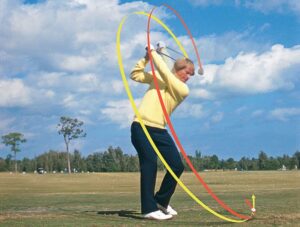If you are suffering from inconsistent hits you may find that your practice swing is perfect but your actual swing at the ball is changing. Moving forward to that little white ball may be changing your physical and mental outlook. I’ve seen many golfers (including myself) change their setup and swing as they move up to the ball. It seems that our minds has a mental “rush” to hit that ball harder and further.
A consistent swing starts with a great setup and a PERFECT PRACTICE SWING. Unfortunately I can see a change come over my playing partners. It’s like the Grim Reaper takes over their bodies as they tense up. The longer they stand over the ball, thinking about their 20 swing thoughts, the tighter they get.
Here are 2 changes that you should be doing to make sure that your PRACTICE SWING is identical to your ACTUAL SWING.

Justin Thomas won the Fedex Cup and $10 Million because he did not tense up or lose his focus. So Keep Your Swing Consistent and Stay Loose.
A. Make Sure that Your Physical Setup is Consistent
I just discovered that I have been changing the drop of my arms every time I move forward from my practice swing to my actual swing. Reaching out with my arms is a bad idea. Almost every golf instructor (except Moe Norman) tells us to drop our arms straight down from our shoulders to grip the club in your setup position.
Unfortunately, pros that I have been watching during tournament telecasts appear to be stretching their arms forward toward the ball. This may be a distortion from the TV camera but it was sinking into my mind as a good position for me. During my swing my arms were returning to the correct dropped position directly below my shoulders and this was often causing fades or mishits off the toe of my club. This is just an example how one small change can cause problems.
B. Don’t let your Mind Tense up Your Body
The longer you stand motionless over the ball, the greater the chance that you will freeze up and loose the natural rhythm of your practice swing.
Your swing really is like a simple dance step. You should be using a waggle to avoid freezing your hips or shoulders. I love to use the Rickie Fowler, Mike Weir or Justin Thomas waggle. Its just a rehearsal to start rotating my shoulders (with a straight leading arm) as I point my club head at my imaginary target line extending back from my ball. A training Video by Alex Elliott Golf not only uses this motion but he also points the butt of his club at that line throughout his backswing to stay on one plane.
What a great idea to minimize angles in your swing. Ben Hogan and Mike Bender both use the concept of pointing your club head and then the butt of your club along the plane of your target line to eliminate angles.
Consistent hits builds a confident golf swing. Duplicate your practice swing and minimize your angles with a relaxed swing for more consistent golf. Learn your consistent rhythm by practicing with GOLFSTR. Buy one today at www.golfstr.com



